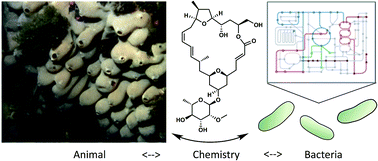Parallel lives of symbionts and hosts: chemical mutualism in marine animals
Abstract
Covering: up to 2018
Symbiotic microbes interact with animals, often by producing natural products (specialized metabolites; secondary metabolites) that exert a biological role. A major goal is to determine which microbes produce biologically important compounds, a deceptively challenging task that often rests on correlative results, rather than hypothesis testing. Here, we examine the challenges and successes from the perspective of marine animal-bacterial mutualisms. These animals have historically provided a useful model because of their technical accessibility. By comparing biological systems, we suggest a common framework for establishing chemical interactions between animals and microbes.

- This article is part of the themed collection: The Chemistry of Symbiotic Interactions


 Please wait while we load your content...
Please wait while we load your content...